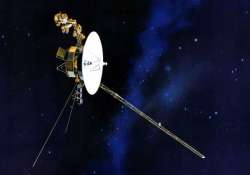Voyager 1 now in inter-stellar space
Washington: Thirty-seven years after it was launched, Voyager 1 is not only alive and kicking, but continuing its journery into the great void.Lunched in 1977, the spacecraft has entered inter-stellar space, the first man-made object

Washington: Thirty-seven years after it was launched, Voyager 1 is not only alive and kicking, but continuing its journery into the great void.
Lunched in 1977, the spacecraft has entered inter-stellar space, the first man-made object to do so, the US National Aeronautics and Space Administration (NASA) said.
Inter-stellar space is the region between the stars filled with a thin soup of charged particles, also known as plasma. NASA said last September that Voyager 1 might have left the sun's heliosphere and entered inter-stellar space Aug 25, 2012.
"Normally, inter-stellar space is like a quiet lake," Xinhua quoted Ed Stone, the Voyager mission's project scientist, as sayibng. "But when our sun has a burst, it sends a shock wave outward that reaches Voyager about a year later. The wave causes the plasma surrounding the spacecraft to sing."
NASA said three such waves had reached Voyager 1 since it entered inter-stellar space in 2012.
The first was too small to be noticed when it occurred and was only discovered later, but the second was clearly registered by the spacecraft's cosmic ray instrument in March 2013.
Thanks to the second wave, the mission team acquired evidence that Voyager had been flying for more than a year through plasma that was 40 times denser than measured before -- a telltale indicator of inter-stellar space.
A third wave was registered in March this year, and data showed that the density of the plasma was similar to what was measured previously, confirming the spacecraft was in inter-stellar space.
Voyager is the only human-made probe farthest from the Earth, and the first to enter the vast sea between stars.
Lunched in 1977, the spacecraft has entered inter-stellar space, the first man-made object to do so, the US National Aeronautics and Space Administration (NASA) said.
Inter-stellar space is the region between the stars filled with a thin soup of charged particles, also known as plasma. NASA said last September that Voyager 1 might have left the sun's heliosphere and entered inter-stellar space Aug 25, 2012.
"Normally, inter-stellar space is like a quiet lake," Xinhua quoted Ed Stone, the Voyager mission's project scientist, as sayibng. "But when our sun has a burst, it sends a shock wave outward that reaches Voyager about a year later. The wave causes the plasma surrounding the spacecraft to sing."
NASA said three such waves had reached Voyager 1 since it entered inter-stellar space in 2012.
The first was too small to be noticed when it occurred and was only discovered later, but the second was clearly registered by the spacecraft's cosmic ray instrument in March 2013.
Thanks to the second wave, the mission team acquired evidence that Voyager had been flying for more than a year through plasma that was 40 times denser than measured before -- a telltale indicator of inter-stellar space.
A third wave was registered in March this year, and data showed that the density of the plasma was similar to what was measured previously, confirming the spacecraft was in inter-stellar space.
Voyager is the only human-made probe farthest from the Earth, and the first to enter the vast sea between stars.